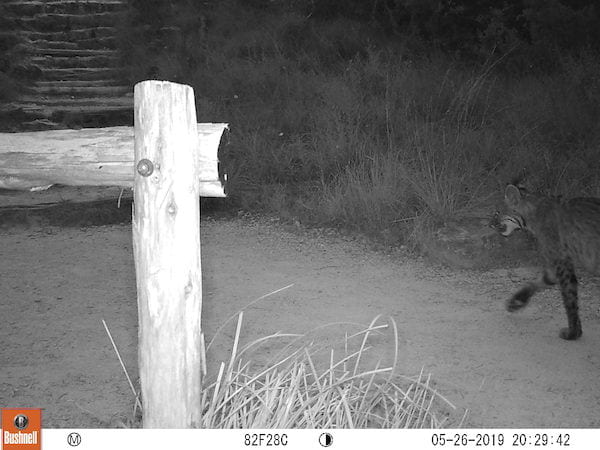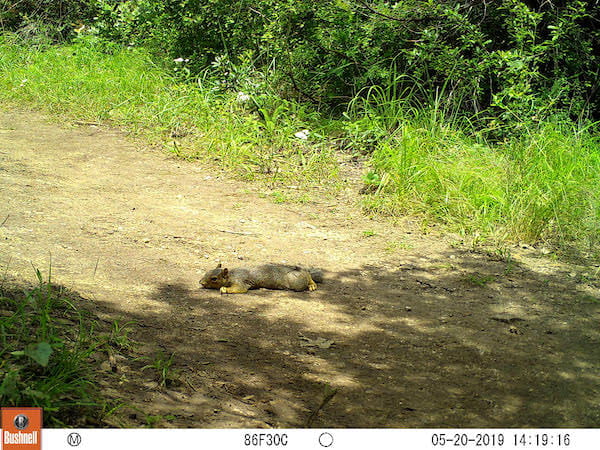Do you ever wonder what the animals in your favorite hiking areas are up to? Armed with a wildlife camera, Paul Finch ’21 is capturing images of animals at Wild Basin to find out. In research partially funded by an NSF grant, Paul is working with Dr. Barbara Dugelby at Wild Basin Creative Research Center to study how wildlife use of trails is impacted by human foot-traffic. Paul spent a few minutes with us to share more about his research experience.
- A bobcat is captured prowling the trails at Wild Basin.
- An eastern fox squirrel takes a break on a shaded trail at Wild Basin.
- A gray fox is seen with a rabbit in its mouth.
Tell us about your research.
Paul: Wildlife cameras have been used in many ecology studies to learn more about animal behavior when humans aren’t looking or present. Wild Basin is no stranger to camera studies. Motion-triggered camera data have been used in several studies at the preserve in recent years. For example, cameras have been set along the perimeter to study animal movement in and out of the preserve. For my project, Dr. Dugelby and I installed cameras aimed at on the trails. We’ve set up 13 cameras along the Wild Basin’s trail network. Our research will highlight what influence human foot-traffic has on wildlife use of the trails. Especially interesting to us is to see what our data suggests for nocturnal activity. We expected low photo captures of wildlife at camera locations of the busier trails. That has been supported by what we’ve seen so far of our pictures! Per each camera site, we document the daily human activity. That is, how many individual hikers pass a camera each day. We also score and identify the wildlife species (e.g., gray fox, coyote, etc.) seen on these cameras. We will analyze this data alongside with pre-existing off-trail camera data to assess how human foot-traffic may be impacting wildlife behavior in the preserve. Hopefully, this could be an important study to conceptualize human impact on nocturnal wildlife. We might even be surprised to see what this study could suggest for behaviors of certain species in our own backyard!
What’s been the most interesting discover so far?
Paul: Thus far (with 2.5 weeks of data), we’ve seen high abundance of coyote, deer, and grey fox in that order. It’s interesting to know that coyotes and fox seem to use the trails at night. So far, there have even been two images of a fox carrying prey! However, we haven’t seen deer as abundantly as we had expected. That is, until we started going through images this week and started finding deer in many pictures.
What’s coming next for you and this research?
Paul: I am a Biology major planning to graduate in May 2021. I would like to pursue a Master’s in Ecology or Conservation Biology. I wanted to get into research sooner rather than later, so that’s why I’m so grateful for this experience to work at Wild Basin for my first ever research project! Research allows me to hone in and develop my skills while letting me explore all kinds of interest and find what works for me. Hopefully, I can continue doing similar studies to this one. Either that or graduate up to marine biology or botany research in graduate school. Both of which are major interests of mine, but I’m keeping my options open. No matter what, I would like to study and teach ecology so I can make an impact on the next generation of scientists.
Although this portion of the study will conclude in July 2019, Wild Basin plans to continue the study for at least another 6 – 12 months to look at seasonal trends in both human and wildlife use of trails.
Story as told to Alexandra Hill


